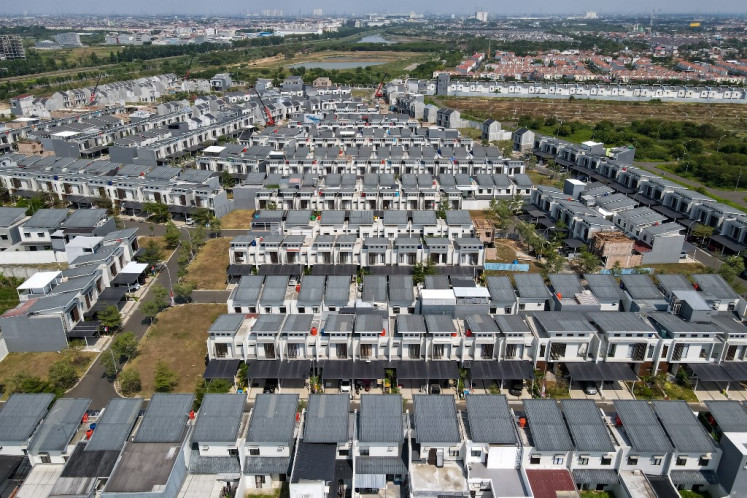Popular Reads
Top Results
Can't find what you're looking for?
View all search resultsPopular Reads
Top Results
Can't find what you're looking for?
View all search resultsHow EVs cannot be truly green in coal-dependent RI
EV batteries, for example, are built from critical minerals such as manganese, cobalt and nickel, which extractions have caused environmental and labor hazards in Indonesia.
Change text size
Gift Premium Articles
to Anyone

P
utra Adhiguna, an energy analyst at the Institute of Energy Economics and Financial Analysis (IEEFA), said over its lifetime, an electric vehicle (EV) will have significantly less impact on the environment than its internal combustion engine equivalents.
“As several studies have suggested, EVs aren’t exactly green from the get-go. We need to consider the carbon footprint at the moment they roll off the production line, for instance,” he said.
EV batteries, for example, are built from critical minerals such as manganese, cobalt and nickel, which extractions have caused environmental and labor hazards in Indonesia.
In January, police reported that an Indonesian and a Chinese worker died after a clash broke out following a protest staged by a labor group at PT Gunbuster Nickel Industry (GNI) smelter in North Morowali, Central Sulawesi.
There are also reports from environmental groups about pollution coming from nickel production sites in Sulawesi and the Maluku islands.
The EV batteries disposal once they degrade and become unusable is another issue. These batteries contain hazardous chemicals such as sulfuric acid, as well as heavy metals such as lead and cadmium. Therefore, they can pollute the soil and water if disposed of improperly.
Arwani Hidayat, chairman of the Indonesia Electric Car Community (Koleksi), says the Indonesian government has a plan to build factories that will recycle EV batteries.
“Unless the grid that powers EVs adopts cleaner energy sources, the impact of moving from fossil fuel to electric transportation will be negligible,” said Putra.
To make electric cars more sustainable and realize their full environmental and health benefits, stakeholders need to make sure that the electricity supply used for making and running electric cars comes from renewable sources, according to a 2018 European Environment Agency (EEA) report.
“We also have to make sure these cars last. Squeezing the mileage out of every electric car that is being produced is vital,” the report reads.
“So if it is just driven for 70,000 kilometers and then the user stops using it, the overall environmental performance does not look so good compared with conventional cars because the extra energy used for its production is more than that of a conventional car.”
In countries where electricity generation comes intensively from coal, the benefits of EVs are smaller and they can have similar lifetime emissions to the most efficient conventional vehicles, such as hybrid-electric models, climate scientist Zeke Hausfather said in an article published on the United Kingdom-based news site Carbon Brief.
The state-owned electricity company PLN in its 2021-2030 electricity procurement plan has targeted renewable energy capacity in the national energy mix to reach 52 percent or 20.92 gigawatts (GW), while coal-fired plants are expected to fill-in only 13.81 GW or 34 percent.
However, renewable infrastructure progress in Indonesia is painstakingly slow.
Renewable energy share in Indonesia’s primary energy mix has reached only 14.11 percent in 2022. Coal share, on the other hand, increased to 67.21 percent in the same year, representing the 42.1 GW of installed capacity of coal power plants in the country, the Energy and Mineral Resources Ministry data show.
Meaning, unless a user is lucky enough to get all their electricity from residential solar panels, an electric vehicle in Indonesia is actually powered by coal.
Factors affecting solar panel price include the size of the user's roof. In Indonesia, a larger system will cost more in total, but the unit cost per kilowatt-peak (kWp) will be lower and more cost-effective, according to Singapore-based solar panel installer Solar AI.
The company source estimated a 6 kWp system to cost a user approximately Rp 15 million per kWp, but that installing a larger 20 kWp system would cost around Rp 12 million per kWp.
It will take massive investment. Will consumers pay for this?
“Yes, I’m trying to get the best deal to install rooftop solar panels and I know a lot of people from the electric-car community who are interested in them as well,” Arwani said.
Amid an unprecedented expansion in the renewable energy sector, some businesses and individuals have shifted to solar power systems.
The government expects solar power, one of the world’s fastest growing renewable energy technologies, to lead the way to achieving at least 23 percent renewable energy in the country by 2025 and at least 31 percent by 2050, as dictated by the National General Energy Planning (RUEN) road map.









